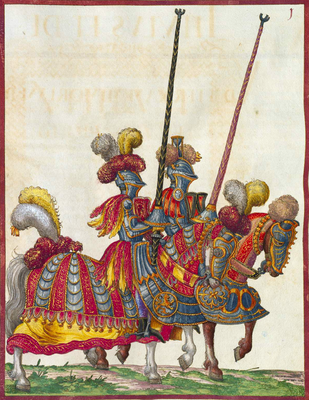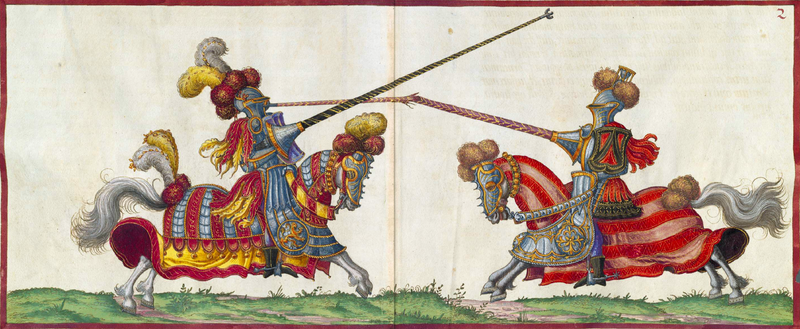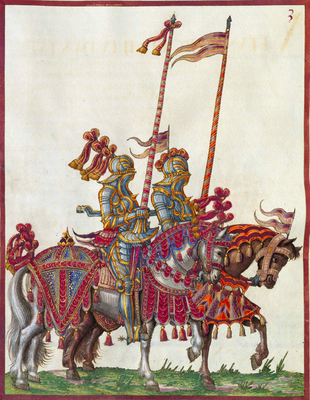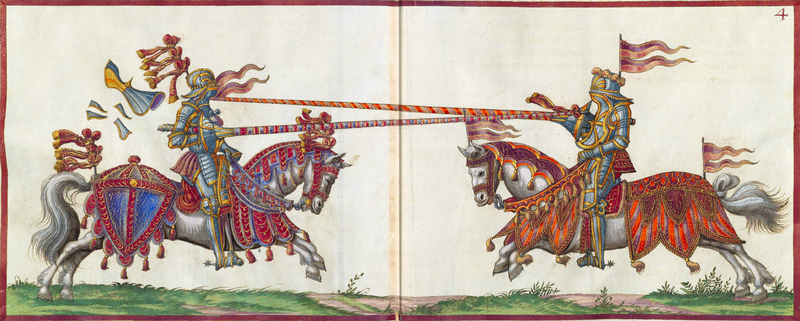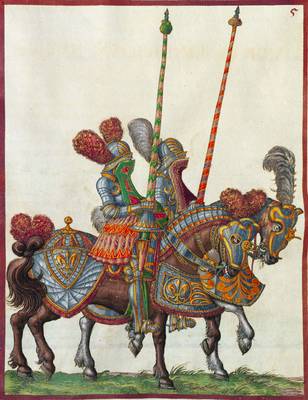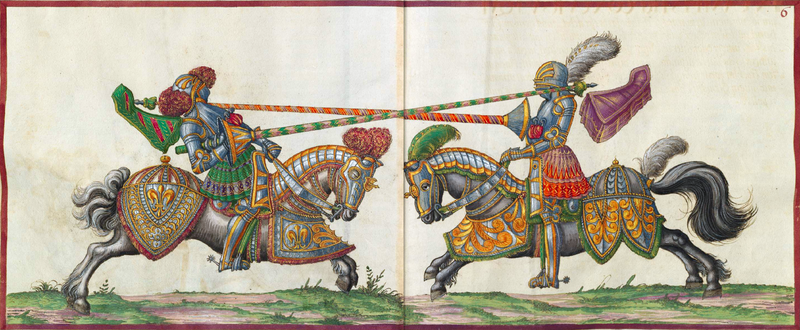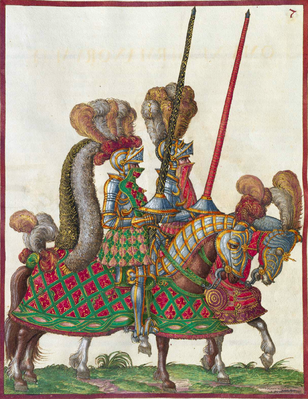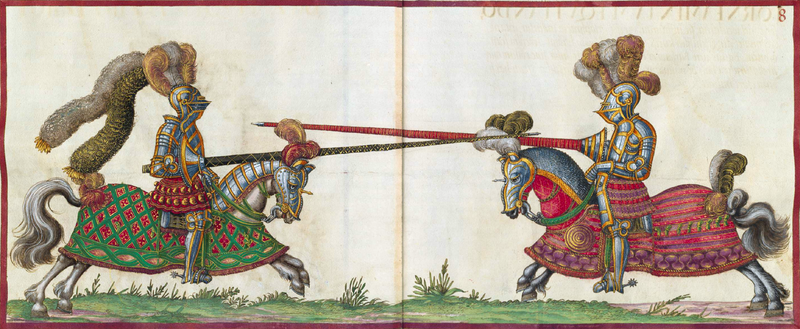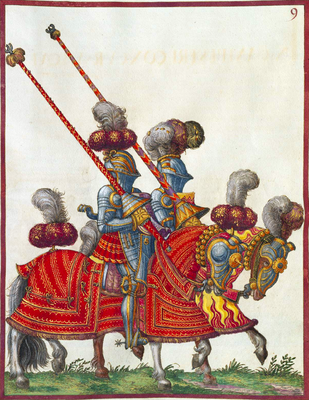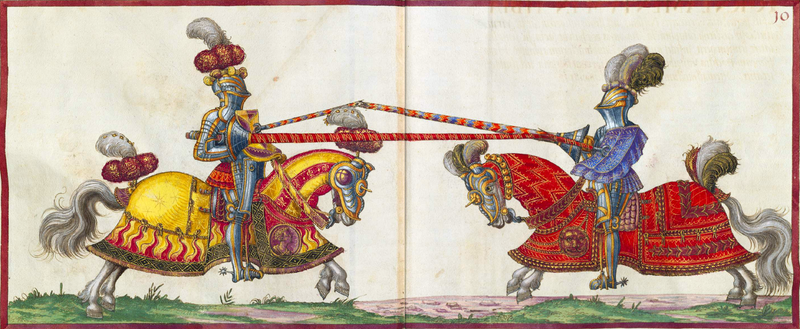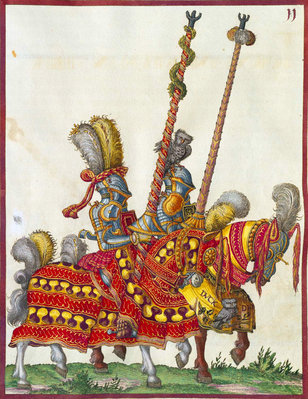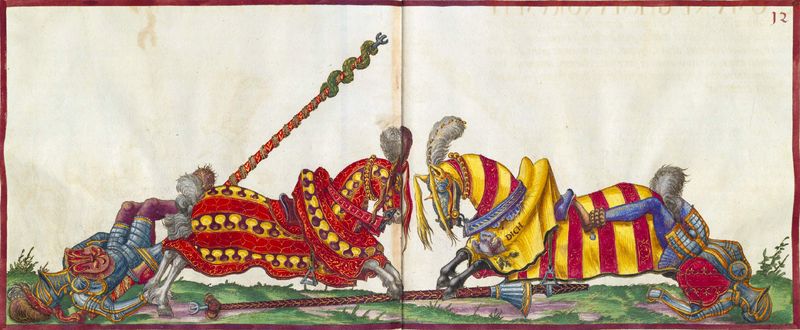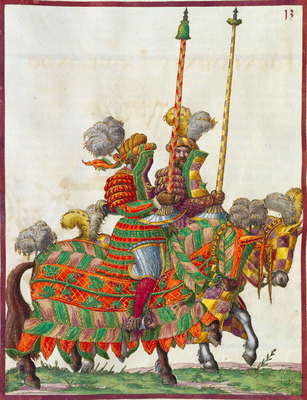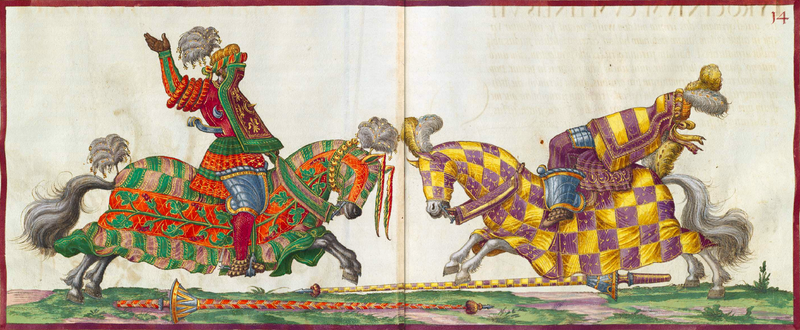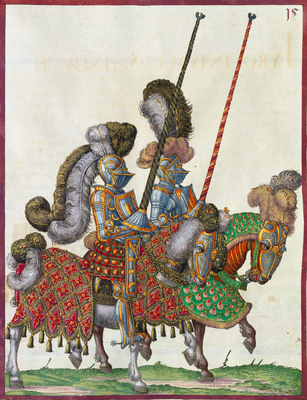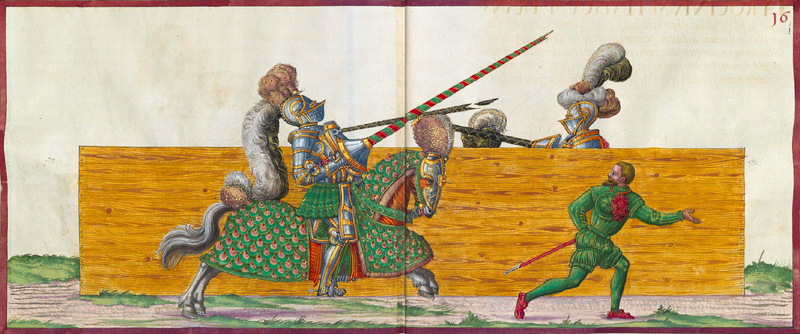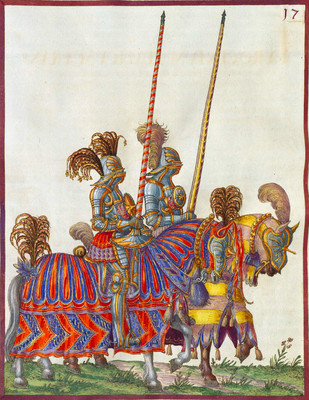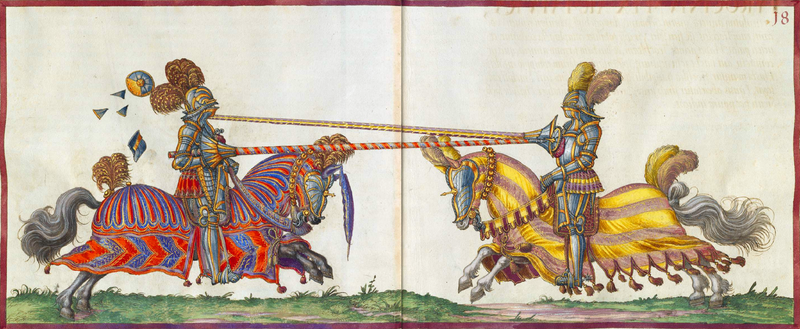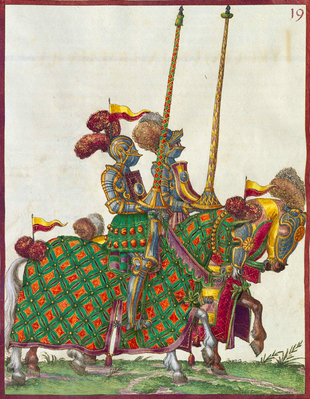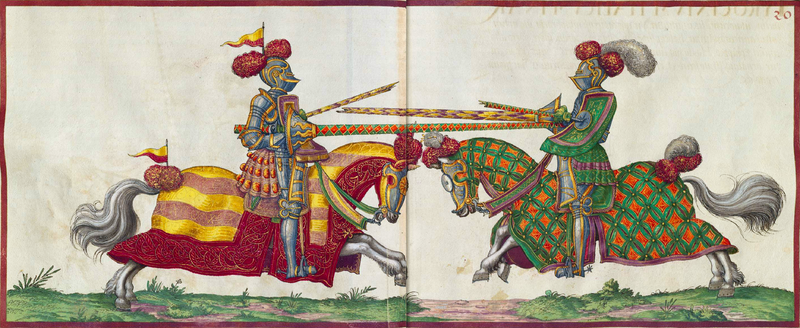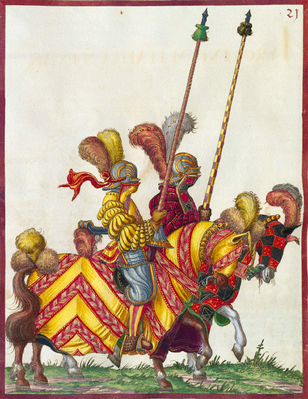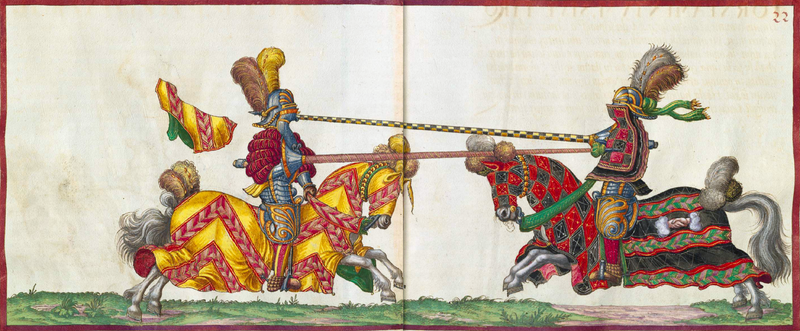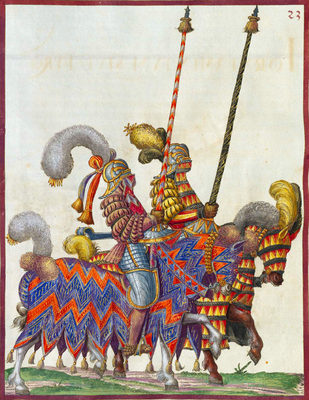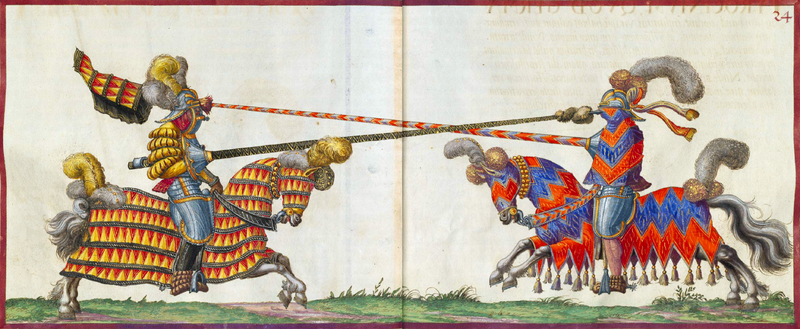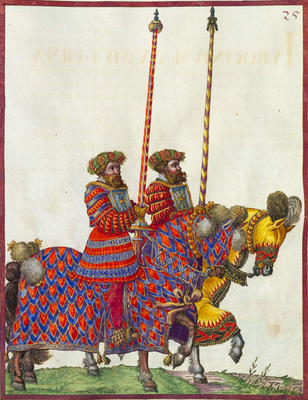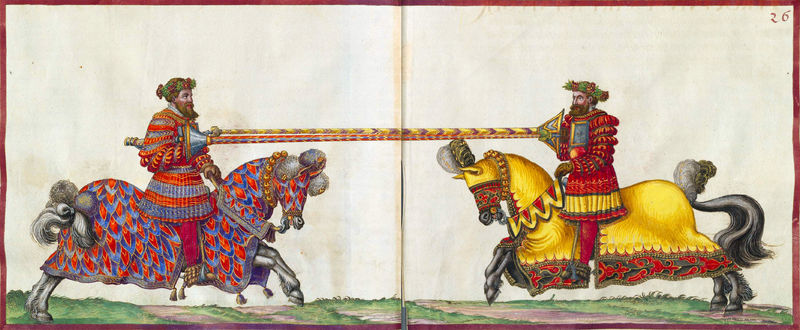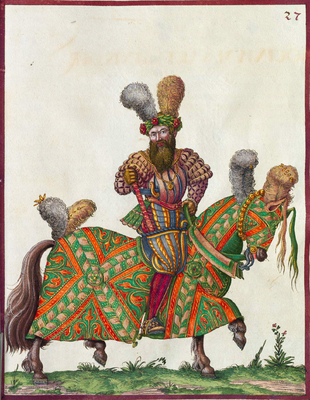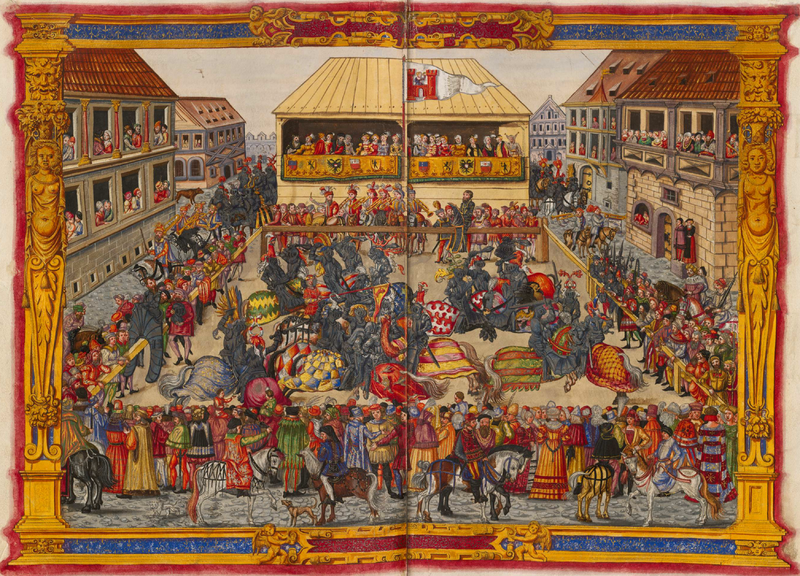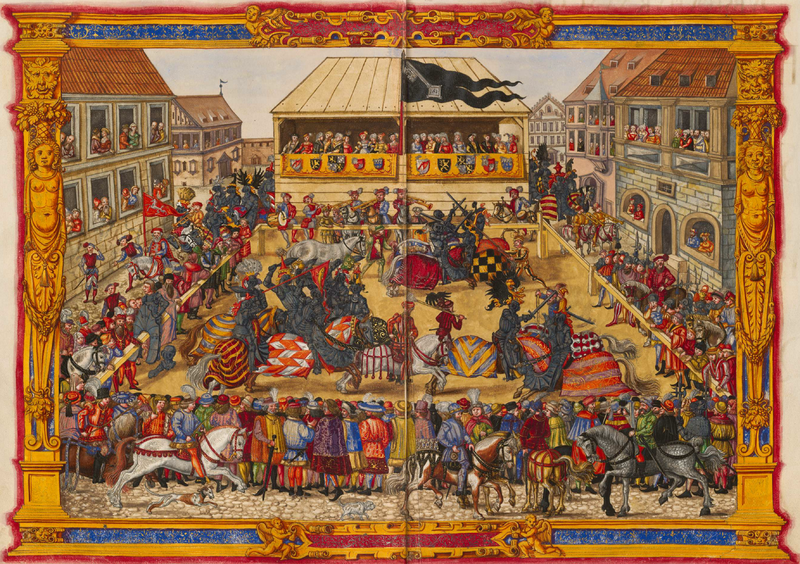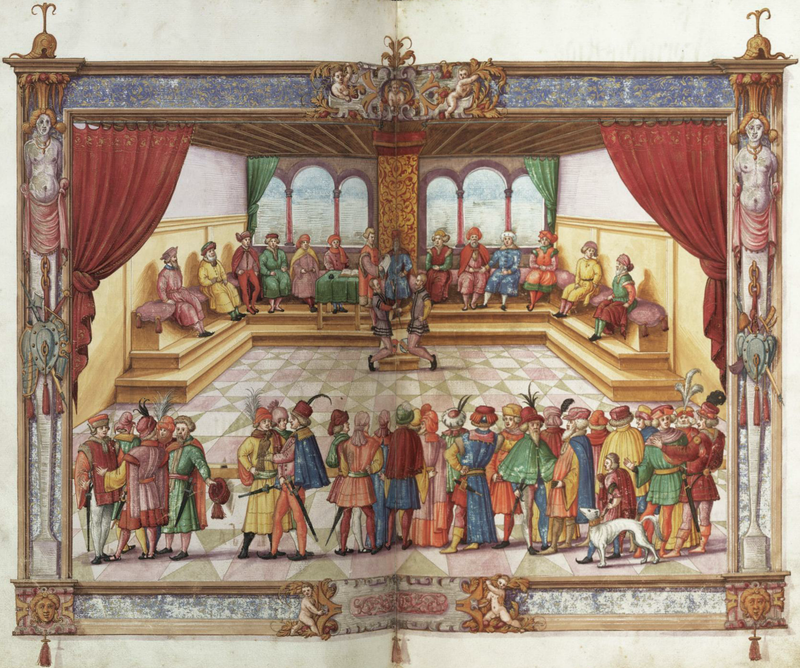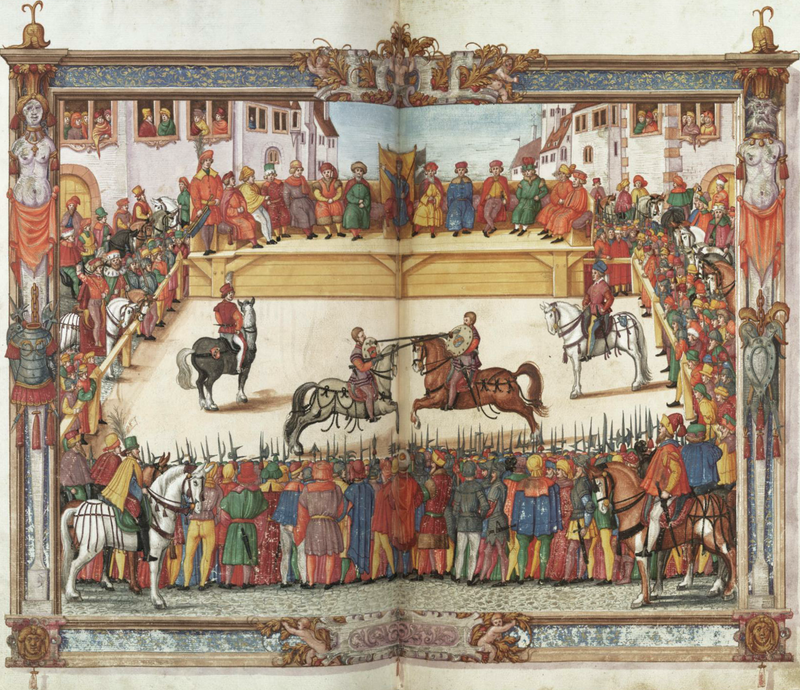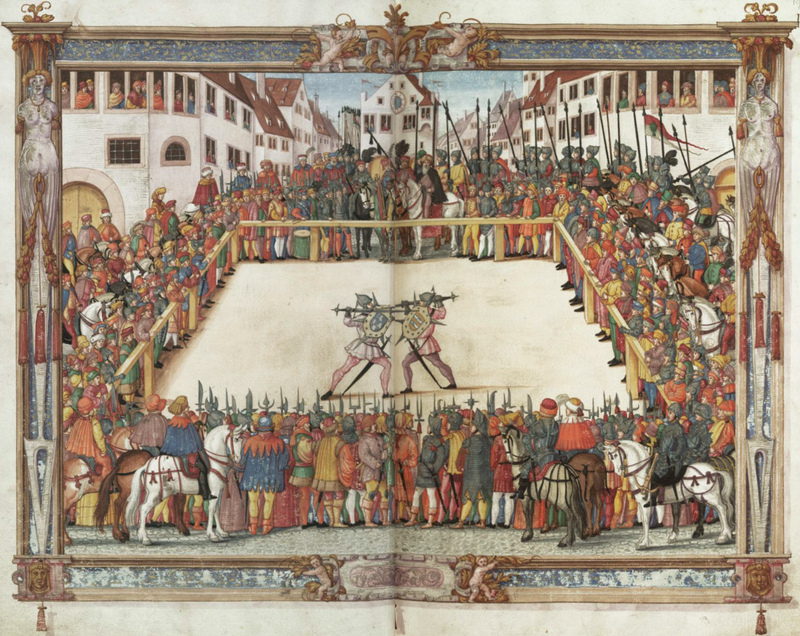|
|
You are not currently logged in. Are you accessing the unsecure (http) portal? Click here to switch to the secure portal. |
Paulus Hector Mair/Tournament book
Source Images |
Dresden II Transcription (1540s) |
Vienna II Transcription [German] (1550s) |
Vienna II Transcription [Latin] (1550s) |
Munich II Transcription (1540s) |
Draftbook Transcription (1540s) | ||
|---|---|---|---|---|---|---|---|
The various old and new noble and knightly German forms and Disciplines of jousting or ”tilt”, as they call it nowadays. |
[095r] Veterum Germanorum, et novissimorum principum etiam Tyrociniorum, vel ut hodie vocant, certaminum equestrium alioquot species, et formae. |
||||||
Title and dedication To the eternal memory of the late Roman Emperor Maximilian, I have here gathered these jousting or tilt games, and put them in order. The late emperor Maximilian himself devoted himself and exercized himself in them, and he even invented many of them as well. Therefore lest this honourable and sportly exercise of the nobility would to perish, I have here given them to posterity, especially for the eternal praise to those who still devote themselves and love it, which can be understood here, how to do that they have before their eyes, so that they be able to reconstruct each and everyone of them. |
[095v] Titulus, et dedicatio. Ad aeternam memoriam divi Maximiliani Romanorum Imperatoris, Caesaris, et Augusti, has Tyrociniorum seu ut nunc vocant Certaminum equesterum[!] species collegi, atque ex ordine locavi. His enim ipse D. Maximilianus studuit, easque exercuit, plerasque etiam invenit primus. Quare ne huiusmodi nobilitatis honesta, ludicraque exercitia pereant, ea immortalitati donavi: presertim ad aeternam laudem nobilitatis, et eorum omnium, quibus huiusmodi ludi adhuc cordi sunt, ut scilicet hinc, quid sequi debeant ad oculum habeant, et sibi singula ad imitationem proponere possint. |
||||||
Old jousting, or tilting as it is called today in old high armour (German: Im hohen zeug), where both break their lances, they enter the field (German: auf die pan), or the arena. The rider himself wears a common jousting armour, he has small rings[1] with a vamplate. He sits on an old high jousting saddle. The horse’s chest guard is stuffed with straw, and padded under the silk caparison. The chanfron is made out of steel, as can be seen in the picture here. Here they both go forth to the jousting field, and descend into the arena in the old armour that the Germans call "high" (in dem alten hohen Teutschen zeug). |
[097v] Vetus tyrocinij ludus est sive ut hodie vocant, ludicrum exercicium, in armatura alta (germanicè Im hohen Zeug·) ubi uterque hastam frangit, et ad hunc modum armati in harenam descendunt, aut ad stramentum (germanice ·auff die pan·) veniunt. Vir ipse induitur comuni Torneamenti armatura, corollas fert, cum Trochleis facile frangibilibus; Ipse porro insidet Ephippio ad Torneamentum vetus convenienti. Antilena equi stramine expletur, et suffarcinatur. Stratum equi ex serico fit, Frontale vero ex Chalybe. Sicuti haec figura presens omnia indicat. [096r] Sic ambo prodeunt ad stramentum, atque descendunt in harenam, in veteri armatura, quam Germani altam (In dem alten hohen Teutschen zeug) Vocant. |
||||||
Here they both ride towards each other in said old high armour. |
[096v97r] Sic congrediuntur, atque in congressu cominus franguntur utrinque hastae, in veteri arnatura, quam altam à Germanis vocari dixi. |
||||||
The commonly practised sportly jousting, that the Germans call "das geschifften Tarschen Rennen", is performed as follows: the rider is clad in field armour, and an old helmet with a steel beard attached to it, that flies off at first contact with the lance. His boots and thighs are covered in armour, and the horse has a caparison. The lance has a large movable vamplate, that covers half the rider’s arm, as can be seen on the picture. Here they both enter into the arena with shields that the Germans call "die geschifften dartschen". |
[095r] |
||||||
Then they engage each other in this manner with said shields. |
[095r] |
||||||
In field jousting, where all armour must be plate armour, that the Germans call "den Bund in stechlin geliger", is done thusly: the man himself is completely covered by a full field armour, and an old helmet covers his head, to which a metal beard is attached which flies off at first contact with the lance. The lance has a vamplate. Furthermore the horse is equipped with armour that Germans call "das Creutz geliger", as can be seen in this picture. Here they both proceed to the arena to compete in field jousting with plate armour that the Germans call "das Stechlin geliger". |
[095r] |
||||||
Here they both engage each other in said jousting with plate armour, as mentioned. |
[095r] |
||||||
Jousting either in ernest or for sport, is performed thus: the rider wears an armour that in German is called "den geschifften küriss". The lance has a vamplate. The horse is equipped with a caparison made out of leather. The mane and neck of the horse is covered in steel armour, as well as the chanfron, as the picture clearly shows. In this manner the jousters enter the arena.[2] |
[095r] |
||||||
Here they engage each other, either for sport or in ernest. |
[095r] |
||||||
Jousting in steel leg armour, as well as leather caparison, ie horse cover, is this: the rider wears field armour and a metal helmet. On his left side he carries a shield. He sits on a high knight saddle, the lance is made with a vamplate, whereas the horse is covered with a leather caparison, as is shown in the picture. This way the two combatants proceed to the arena in steel leg armour. |
[095r] |
||||||
Then they run towards and engage each other in metal leg armour. |
[095r] |
||||||
Common German jousting is done thus: the rider wears a common jousting armour, and in the lance he has coronells and a vamplate. He sits on a cushion, without saddle. The horse has covered eyes, as well as ears. The caparison is wholly made out of silk. Furthermore, the rider has large enough bundles of straw on the chest under the caparison, as is illustrated on the picture. Thus they enter the arena, in common German jousting, or tilt. |
[095r] |
||||||
Thus they run at each other in said common German jousting. |
[095r] |
||||||
Jousting with linen bindles, that Germans call "das rennen mit dem Wulst", is performed thus: the rider has a large linen bindle on his head, and apart from that completely without armour. He carries a metal beard hanging from his neck, with a large hook that supports the lance, and this hook is the only thing aimed at by the lance hit. Furthermore, he has armour plate protection over his knees. The lance has a vamplate, that covers half the man’s arm. He sits on a pillow. The horse is covered and blindfolded by a silk caparison, as you can see in the picture. Here the combatants enter the arena to compete with linen bindles, or "in Wulsten" as Germans use to call it. |
[095r] |
||||||
Here they ride together with said linen bindles. |
[095r] |
||||||
Italian jousting over the tilt barrier is done thus: the rider is equipped with a field armour that we in German call "ain geschifften feldküriss". He wears a helmet suitable for this sort of jousting, and on his left side he carries a shield with a grill. He sits on a high knight's saddle. The hit, or strike is on the shield. The horse is covered with a silk caparison, and its forehead is protected by a steel chanfron, as the picture shows. This way they enter the arena to compete over the tilt barrier. |
[095r] |
||||||
This is the way jousting over the tilt barrier is done the Italian way. |
[095r] |
||||||
Jousting in articulated armour, in German called "das geschifft scheuben rennen", ie with movable discs, is done thus: the rider is fully covered in armour, and an old helmet. Furthermore he has a disc, and a steel beard attached, that by the contact or hit of the lance, flies off. He sits on a knight saddle. The lance has vamplate, that covers half the man’s arm. The horse is blindfolded and covered by a silk caparison, and its forehead is protected by a steel chanfron as shown in this picture. Thus they enter the arena to compete with discs, that the Germans call "die geschifften scheuben". |
[095r] |
||||||
Here they engage each other with said discs. |
[095r] |
||||||
Italian jousting in armentin, as they call it, is done thus: the rider wears an articulatedly-attached field armour, and a has a sleeve/shirt in a knightly fashion. Furthermore, he sits on a high saddle. The lance has vamplates. The horse is blindfolded and covered with a silk caparison, and wears a steel chanfron, as you see in the picture. Thus the combatants enter the arena to compete in Italian Armentin. |
[095r] |
||||||
Then they ride towards each other in said Italian armentin. |
[095r] |
||||||
The common strifing joust or tilt called "der schwaiff"[3] by the Germans, is to be performed as follows: the rider wears shoulder and chest armour that must be equipped with a large hook. On his head he wears an old helmet with a long steel beard hanging from it, that immediately flies off at lance contact. The arms are unprotected, and on his knees he is protected by the armour called "streiffteschen" in German. The lances have moveable vamplates that cover half the man’s arm. The horse is blindfolded by his silk caparison, as you may discern from this picture. Thus they enter the arena to compete in strifing jousting, called "der schwaiff" in German. |
[095r] |
||||||
Then they ride towards each other in said strifing jousting. |
[095r] |
||||||
Jousting called ”den Bund” in German is performed thus: the rider himself wears a helmet that we in German call "ain Rennhuet", and a harness equipped with a large hook. Furthermore he wears a metal beard, that flies off at first contact with the lance. On the arms there is no armour, but on the other hand his knees must be protected with what is called "die straiffteschen". No saddle is to be used. The lance has a movable vamplate, that covers half the man’s arm. The horse is covered in a silk caparison, and blindfolded by it, as you may understand from this picture. In this manner they enter the arena to the joust in what the Germans call "den bund". |
[095r] |
||||||
Here they ride at each other, in said sportly joust. |
[095r] |
||||||
Pan jousting, or in German "das pfannen rennen", is performed in this manner: the rider has no armour at all, on his chest he has a large shield with a steel grill, in which the lance is stuck, and must keep it there. He sits on the horse without any saddle. The horse itself is covered and blindfolded by a silk caparison, as is clearly displayed in this picture. Thus they enter the arena to compete in jousting with pans, called "in der pfannen" in German.[4] |
[095r] |
||||||
Then they run at each other in said pan joust. |
[095r] |
||||||
The end. |
[095r] |
||||||
[095r] |
|||||||
[095r] |
|||||||
[095r] |
|||||||
[095r] |
|||||||
[095r] |
|||||||
[095r] |
|||||||

